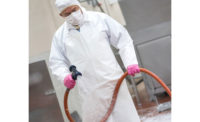Safe Keeping
By Deborah Silver,
Contributing Editor
Contributing Editor
OSHA wants an injury-free workforce. Here’s how it plans to achieve that goal.
In 2003, the percentage of work-related injury or illness in meatpacking plants dropped to 13 percent from 39 percent a decade earlier, according to the Bureau of Labor Statistics. Prepared meats saw an 8.5 percent decline during that period.
No doubt, the Occupational Safety and Health Administration (OSHA) would give some credit to its Voluntary Protection Program (VPP), started in 1982 to promote effective worksite safety and health. Although VPP has not taken the meat industry by storm — only a small percentage of plants with VPP status are meat-related — it appears at last to be gaining ground.
Processors such as Aurora Packing Co., Armour Swift-Eckrich, Cargill and Kraft have VPP initiatives, with positive results. Aurora, for example, has put in place hundreds of safety improvements since adopting the program in 1989 — most of them based on employee suggestions. “VPP empowers employees to better their work environments, which is one big reason why it works,” says Michael Fagel, corporate risk manager for Aurora, Ill.-based Aurora Packing.
How VPP works
In practice, VPP sets performance-based criteria for a managed safety and health system, inviting facilities to apply and then ultimately assessing applicants against established criteria. The verification process includes an application review and a rigorous on-site evaluation by a team of OSHA experts. To qualify for VPP status, a plant must implement management systems that provide integrated, comprehensive and ongoing safety and health protection that exceeds the current requirements of the agency’s standards. On average, managers and employees work from one to two years to develop and implement the safety and health regimen required by the program.
VPP bestows on participating plants one of three grades — Star, Merit and Star Demonstration. Star recognizes employers that provide effective, comprehensive work safety and health protection. Merit status is presented to those facilities that provide good protection and commit to reaching Star level. Demonstration belongs to plants willing to indicate their capability of attaining Star level, but that need OSHA’s help to identify an effective course of action. Any facility that makes the grade must submit annual self-evaluations and undergo periodic on-site re-evaluations to remain in the program.
Clearly the greatest benefit to adopting VPP is reduction of injuries and illness. But for VPP companies there are other incentives, primarily the higher profits that result when workers’ compensation premiums and other costs drop.
“The meat industry used to accept that it was a tough place to work and the risk of injuries came with the territory,” says Dan McCausland, director of worker safety and human resources with the American Meat Institute. “The biggest realization on the part of meat-industry management and workers is that it’s in our best interest and in our power to control the safety of the workplace.”
Ergonomics in action
An increasing number of meat-processing operations are attempting to gain that control through development of an ergonomics program, which addresses work-related musculoskeletal disorders (MSDs) such as tendonitis and carpal tunnel syndrome. Although OSHA has no ergonomics standard — that long-awaited ruling never came to pass — it has voluntary guidelines that target industry-specific ergonomics hazards. Most recently it issued “Guidelines for Poultry Processing: Ergonomics for the Prevention of Musculoskeletal Disorders.” The meat-related version, “Ergonomics Program Management Guidelines for Meatpacking Plants,” was issued more than a decade ago.
Although the guidelines are voluntary, the task of addressing potential ergonomics hazards is not, and for good reason. As recently as 2000, the meat industry led the country in repeated-trauma disorders, with meat plants logging injury rates of 92.2 injuries per 1,000 workers, compared with a national average of 3.3 injuries per 1,000. Poultry plants, by comparison, reported 53.5 injuries per 1,000.
According to OSHA, employers have an obligation under the General Duty Clause, Section 5(a)(1), to keep the workplace free from recognized serious hazards, including ergonomics-related ones. Although OSHA is not focusing its enforcement efforts on employers that have implemented ergonomics programs, it continues to cite companies for ergonomics hazards as part of its overall enforcement agenda.
To handle ergonomics issues, OSHA has developed an approach that helps companies quickly address work-related MSDs and provides industry-specific guidelines and outreach in the form of industry alliances. The American Meat Institute and OSHA, for example, have signed an agreement that calls for a continued focus on reducing and preventing ergonomic hazards. As a condition of the partnership, AMI assists in maintaining and updating the safety and health pages of OSHA’s “Assistance for the Meat Packing Industry,” which includes sections on hazard recognition and reduction. OSHA also has established a National Advisory Committee on Ergonomics, which includes representatives from industry, academia, labor, and the legal and medical professions.
“Many of the solutions are logical and simple,” says McCausland. “A good ergonomics program does not mean that you have to redesign your plant from the ground up.” NP
The Osha-Nebraska Alliance
Nebraska may be known as “The Cornhusker State,” but the state is carving out a new reputation in the meat-processing arena.
In 2000, OSHA’s area office in Omaha entered into a partnership with members of Nebraska’s meat-processing industry, with the goal of addressing the high fatality, injury and illness rates that plagued the state’s meat processors. The alliance came none too soon: Nebraska’s meat-processing industry historically had one of the highest injury and illness rates recorded by the Bureau of Labor Statistics, putting a notable strain on its relationship with OSHA.
With the help of other safety and health organizations, such as the Nebraska Department of Labor-Workforce Development, the Omaha chapter of the National Safety Council and the Nebraska Safety Council, the alliance has shown dramatic results. A few years after it began, the 43 participating facilities reported a 39 percent drop in injuries and illnesses, including cases resulting in days away from work, restricted work or medical treatment.
Participating companies, with help from OSHA representatives, meet bi-monthly to share best practices and discuss safety issues of concern, tackling such topics as ergonomics, noise, lacerations, training bilingual employees and protective equipment. Kathleen Krantz, technical resource director with the Greater Omaha Packing Co., notes that since joining the group, her company’s rate of lost workdays due to injuries and illness has dropped 60 percent. “I’m a firm believer that sharing information and putting best practices in place is the key to success,” she says.






